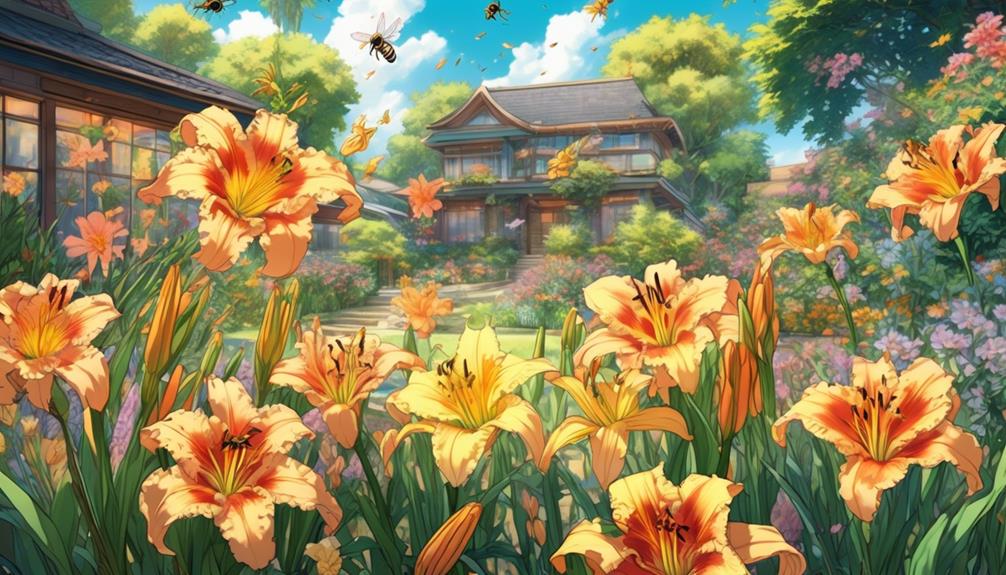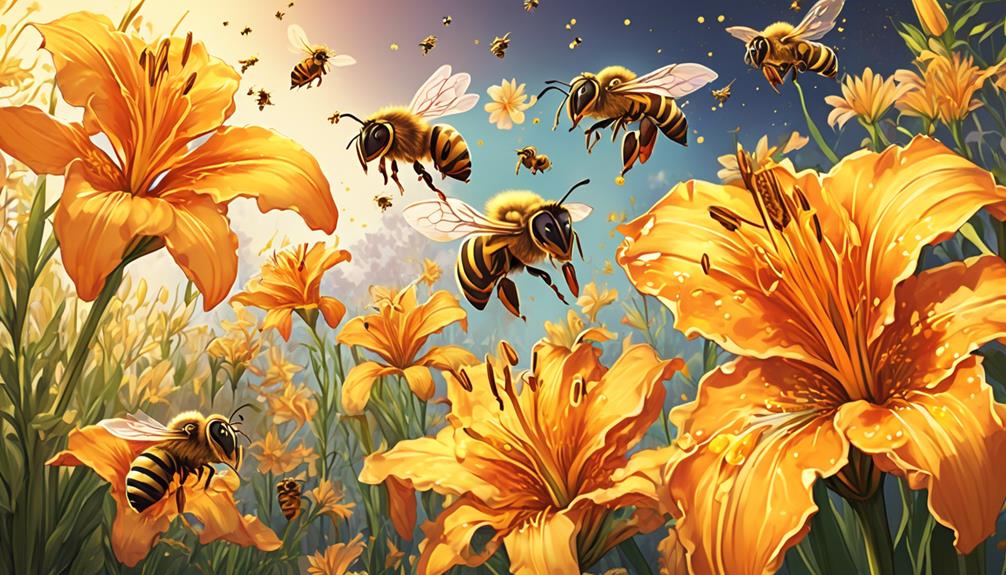Find out the fascinating relationship between bees and daylilies, a partnership that's more intricate and beneficial than you might expect.

Do Bees Like Daylilies?
While you may think that bees are only attracted to certain types of flowers, it's not entirely true. Bees, those remarkable pollinators, show quite a bit of interest in a variety of flora, including daylilies.
You're probably wondering, do bees really like daylilies? Let's just say, it's an intriguing relationship between these buzzing insects and this particular bloom. As we venture into this discussion, we'll explore the allure of daylilies for bees and how it benefits both parties.
You might be surprised at what we discover about this unexpected partnership.
Key Takeaways
- Bees are attracted to daylilies due to their vibrant colors, wide petal spreads, and ample nectar.
- Daylilies play a crucial role in the pollination process as they provide a landing platform for bees to collect nectar and offer a rich supply of pollen.
- Daylilies are beneficial for bees as they provide a rich source of sugars through their nectar, which is converted into energy for flight and honey production.
- Optimizing daylilies for bees involves selecting varieties with vibrant colors and strong fragrances, choosing ones that bloom during the active period of bees, and practicing organic pest control methods to avoid harming bees.
Understanding Bees and Pollination

To fully comprehend why bees might be attracted to daylilies, it's crucial that you first understand the intricate relationship between bees and pollination. Bees, as you might already know, play an essential role in the reproduction process of plants. They're pollinators, transferring pollen from the male anther of a flower to the female stigma. This fertilization process is vital for the production of fruits and seeds.
As they forage for nectar, bees pick up pollen on their bodies. When they visit the next flower, some of this pollen rubs off onto the stigma. They're not intentionally acting as pollinators; they're just looking for food. However, in the process, they facilitate the survival of countless plant species.
The Allure of Daylilies

Now that you've grasped the role bees play in pollination, let's explore the unique allure of daylilies that might entice these industrious pollinators.
Daylilies, scientifically known as Hemerocallis, are characterized by their vibrant hues, wide petal spreads, and tantalizing nectar, which is a veritable magnet for bees.
The color spectrum of daylilies ranges from pure white to deep red, with many boasting bicolored petals. Bees, having trichromatic vision, are particularly attracted to flowers with contrasting colors. Daylilies' vivid tones provide this striking contrast, making them irresistible to foraging bees.
What's more, the structural design of daylilies aids in bee attraction. Their broad, trumpet-shaped flowers offer an easy landing platform for bees. The anthers and stigma are strategically placed for optimal pollen transfer when bees rummage for nectar.
Speaking of nectar, it's the main draw. Daylilies produce an ample supply of this sugary elixir, providing essential energy for bees. The nectar's scent, a subtle blend of sweetness and musk, serves as an olfactory signal guiding bees to the flowers.
Bees' Interaction With Daylilies

Often, you'll observe bees buzzing around daylilies, their legs dusted with pollen as they meticulously collect nectar from each flower's depths. It's not a random act, but a symbiotic relationship. Daylilies attract bees with their vibrant colors and sweet nectar, while bees assist in the plant's pollination process.
To understand this interaction, let's breakdown it down:
Daylily Features | Bee Attraction |
|---|---|
Vibrant Colors | Bees are attracted to bright colors, especially yellow and orange hues of daylilies. |
Sweet Nectar | Nectar serves as a food source for bees, providing essential nutrients. |
Large Petals | The petals offer a landing platform for bees, facilitating their nectar collection. |
Pollen Rich | Bees collect pollen to feed their young. Daylily's abundant pollen supply is a bonus. |
Day Blooming | Bees are active during the day, aligning with the blooming period of daylilies. |
This table underlines the intricate relationship between bees and daylilies. The attraction isn't one-sided; both parties benefit. So, it's no wonder why you'll often find bees drawn to these beautiful flowers.
Benefits for Bees

Diving deeper into the relationship between bees and daylilies, it's clear that these vibrant flowers provide a host of benefits for our buzzing friends.
The nectar of daylilies is a rich source of sugars, particularly fructose and glucose, which bees convert into energy for flight and honey production. This sugary food is vital for their survival and overall health.
Daylilies also offer pollen, another crucial dietary component for bees. High in proteins and lipids, it's essential for larval growth and development. Bees collect this pollen and carry it back to the hive, nourishing their young and ensuring the continuation of the colony.
Moreover, daylilies bloom for a single day, but their flowering period extends over several weeks. This guarantees a consistent food source for bees during this time, supporting their foraging needs. They're also known for their bright colors, attracting bees effectively and aiding in their search for food.
Optimizing Daylilies for Bees

While understanding the benefits daylilies offer to bees is essential, it's equally important to know how to optimize your daylilies to attract and nourish these vital pollinators.
Firstly, select daylily varieties with vibrant colors and strong fragrances. Bees are attracted to bright colors like yellow and orange, and sweet fragrances lure them more effectively.
Equally crucial is the timing of your daylily bloom. Bees are most active from spring to late summer. So, consider choosing daylily cultivars that bloom during this period. This optimizes the chance of pollination and provides a continuous food source for bees.
Your plant care practices also play a role. Regular watering is essential as it helps flowers produce nectar, a primary food source for bees. However, avoid overwatering as it can dilute the nectar concentration, making it less appealing to bees.
Furthermore, avoid using pesticides on your daylilies. These chemicals can harm or even kill bees. Instead, opt for organic pest control methods that are bee-friendly.
Lastly, group your daylilies. Bees tend to visit clusters of flowers rather than individual ones. By creating a 'bee magnet,' you're not only optimizing your daylilies for pollination but also contributing to bee conservation.
Frequently Asked Questions
What Other Flowers Do Bees Commonly Prefer Besides Daylilies?
You're curious about what other blossoms bees favor, aren't you?
In addition to daylilies, bees commonly prefer flowers such as lavender, foxgloves, and cone flowers. They're also particularly drawn to plants like sage, rosemary, and thyme.
It's not just about the color or fragrance for bees. They're attracted to these flowers due to their high nectar and pollen content which are essential for their survival.
Are There Specific Types of Bees That Are Attracted to Daylilies?
Yes, specific types of bees are indeed attracted to daylilies.
Honeybees and bumblebees, in particular, find these flowers appealing due to their bright colors and sweet nectar.
They're drawn to the daylilies' vivid hues, especially red and orange.
The flowers' heavy pollen also provides an excellent food source.
Can Daylilies Be Harmful to Bees in Any Way?
No, daylilies aren't harmful to bees. In fact, they're quite beneficial. Bees are attracted to their vivid colors and sweet nectar. As bees move from flower to flower, they pollinate the plants, aiding in their reproduction.
How Do Daylilies Compare to Other Flowers in Terms of Attracting Bees?
You're probably wondering how daylilies stack up against other flowers when it comes to enticing bees.
Well, they're not the top choice. Bees typically prefer flowers with single layers of petals where nectar and pollen are easily accessible. Daylilies, while beautiful, can be a bit tougher for bees to navigate.
However, they'll still visit daylilies if other favorite flowers aren't available. So, in comparison, daylilies aren't the bees' first preference.
Are There Any Specific Geographical Regions Where Bees Are More Likely to Be Attracted to Daylilies?
Yes, geographic regions do impact bee attraction to daylilies.
In temperate climates, bees are more attracted to daylilies due to their vibrant colors and abundant nectar.
However, in arid regions, bees might prefer plants that are better adapted to the dry environment.
It's important for you to consider the local ecosystem and climate when assessing bee preferences for daylilies or any other flowers.
Conclusion
Indeed, bees are drawn to daylilies' vibrant colors and sweet nectar. They not only enjoy their visit but also aid in the pollination process, contributing to a thriving daylily population.
By optimizing your daylilies, you're supporting a healthier ecosystem and ensuring a steady food supply for these vital pollinators.
So, it's not just about if bees like daylilies, it's about how you can make your garden a haven for these hardworking creatures.



